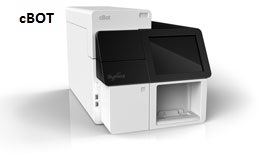BioMicroCenter:Illumina Sequencing: Difference between revisions
| Line 58: | Line 58: | ||
== MIT Core Collaboration == | == MIT Core Collaboration == | ||
Illumina samples | Because of the layout of Illumina flowcells, samples must be run in batches of 7 lanes (a pool of multiplexed samples counts as one lane). In order to ensure quick throughput, we have established a collaboration that allows us to move partial flowcells between the various centers at MIT. For users with less then 4 samples, their samples may be moved between the BioMicro Center, the [http://jura.wi.mit.edu/genomecorewiki/index.php/Main_Page Whitehead Institute Center for Genome Technologies] and the [http://web.mit.edu/biopolymers/www/ Koch Institute Biopolymer Center]. Samples will be moved only to fill out runs or to expedite processing. The Centers are committed to working together to maintain consistent quality between the different cores, so you should see no difference whether your samples are run in BioMicro or at one of our sister centers. Transfers are only available for members of the MIT community. | ||
[[Media:QueueReport.pdf| View current samples queuing for Illumina]] | [[Media:QueueReport.pdf| View current samples queuing for Illumina]] | ||
<BR> | <BR> | ||
''Initial page written by Summeet Gupta at the WI-CGT'' | ''Initial page written by Summeet Gupta at the WI-CGT'' | ||
Revision as of 11:03, 29 September 2011
| HOME -- | SEQUENCING -- | LIBRARY PREP -- | HIGH-THROUGHPUT -- | COMPUTING -- | OTHER TECHNOLOGY |

The MIT BioMicro Center has four high-throughput Illumina sequencers, including a HiSeq 2000. We support a wide variety of applications, such as ChIP-Seq, miRNA sequencing and RNA-seq. Each sequencer can process up to 7 lanes simultaneously, with a data yield of over 25 million reads per lane for the GAIIx and over 120 million reads for the HiSeq (single read). Each lane can potentially accomodate dozens of barcoded samples (depending on sequence complexity and desired coverage). Read lengths vary, depending on users, between 36nt and 150nt per end on the GAIIx and between 40nt and 100nt per end on the HiSeq.
ILLUMINA MASSIVELY PARALLEL SEQUENCING


Illumina sequencing works by binding randomly fragmented DNA to an optical flowcell. Fragments are sequenced by sequentially incorporating and imaging fluorescently labeled nucleotides in a “Sequencing-By-Synthesis” reaction. Illumina recently rolled out its TruSeq v3 reagent kits, improving read quality and reducing GC bias at high cluster densities. As a result, the capacity of the HiSeq has dramatically expanded, so that a single flowcell lane on the HiSeq now produces as many reads as an entire GAII flowcell.
The Genome Analyzer IIx system consists of a cBOT cluster generation station, a Genome Analyzer sequencer, and a Paired-End Module, all of which work in concert to generate and analyze flowcells. The HiSeq system is similar but features expanded capacity and an integrated Paired-End Module.
For an in-depth overview of the Illumina sequencing chemistry, please refer to Kirchner et al 2009.
Applications
Illumina currently provides reagents and support for four major sequencing applications:
The following application has been published but does not yet have a kit from Illumina:
- Genotyping: Protocols are being developed for detection of SNPs, chromosomal rearrangements and other genotyping applications.
Sample Preparation
Illumina sequencing requires the input of libraries which have been properly fragmented, ligated to specific adapters, and, in the case of RNA inputs, converted into complementary DNA. The BioMicro Center accepts fully prepared libraries from users and also offers a variety of sample preparation services for different applications.
Information is also available about multiplexing.
QC
Quality control is very important for optimizing the number of reads and the quality of data produced. We run Bioanalyzer and RT-PCR for all submitted cDNA libraries for Illumina sequencing. For more information on QC methods and protocols please visit the Sequencing Quality Control page.
Data Analysis
Each lane of the flowcell should produce between 10 and 120 million DNA fragments as of March 2010. Understanding this data often requires a significant investment in informatics and many applications require entirely different interpretations of the data. As part of our sequencing service we provide many of the early steps of bioinformatics for different applications. Further data processing can be arranged on a collaborative basis as resources are available. For more information, check out the links below:
Pricing and Priority
Full pricing information is available on our price list.
Priority for Illumina sequencing is currently given to labs associated with the BioMicro Center Core departments. We are able offer our services to other MIT and non-MIT users as space allows.
Protocols
Protocols for all supported technologies can be found here.
MIT Core Collaboration
Because of the layout of Illumina flowcells, samples must be run in batches of 7 lanes (a pool of multiplexed samples counts as one lane). In order to ensure quick throughput, we have established a collaboration that allows us to move partial flowcells between the various centers at MIT. For users with less then 4 samples, their samples may be moved between the BioMicro Center, the Whitehead Institute Center for Genome Technologies and the Koch Institute Biopolymer Center. Samples will be moved only to fill out runs or to expedite processing. The Centers are committed to working together to maintain consistent quality between the different cores, so you should see no difference whether your samples are run in BioMicro or at one of our sister centers. Transfers are only available for members of the MIT community.
View current samples queuing for Illumina
Initial page written by Summeet Gupta at the WI-CGT
